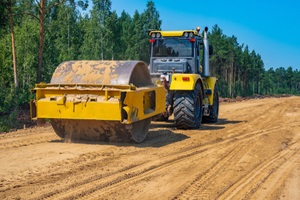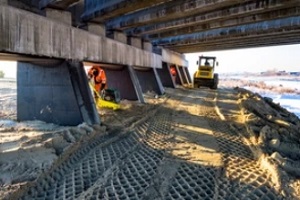 Soil is everywhere, and nearly everything that has been constructed on this planet has soil beneath it. Therefore, it is essential to understand the properties of this abundant resource. Soil is highly susceptible to the elements, and moving it in any way can alter its characteristics dramatically, sometimes turning it from a good base for a building to something highly unsuitable for construction.
Soil is everywhere, and nearly everything that has been constructed on this planet has soil beneath it. Therefore, it is essential to understand the properties of this abundant resource. Soil is highly susceptible to the elements, and moving it in any way can alter its characteristics dramatically, sometimes turning it from a good base for a building to something highly unsuitable for construction.
One important process that soil can undergo naturally is soil consolidation, which occurs when steady and static pressure compresses saturated soil and changes its volume.
When a load is applied to soil that has a low permeability, the water found in the pores of saturated soil will initially carry the load, which leads to a rapid increase in pore water pressure. Then, as the water drains away from the soil’s voids, the excess pore water pressure will dissipate, and pressure will then be transferred to the skeleton of the soil. This soil skeleton will compress gradually and cause settlements. Consolidation continues until all of the excess pore water pressure has dissipated.
SoiI consolidation can occur as a result of natural loads such as sedimentation processes. In addition, human-made loads, such as constructing a building, can cause consolidation to occur.
The concept was first described by Karl von Terzaghi, who is considered the “father of soil mechanics and geotechnical engineering.”
The Stages Of Consolidation
Consolidation in sandy soils tends to be a rather quick process and can take place almost immediately during construction. However, in clay soils, it can last for years or even decades. The soil’s permeability and drainage paths are major factors in the duration of consolidation.
The consolidation procedure can be broken down into three stages.
Initial Consolidation
In this stage, a quick loss of volume in the soil mass occurs under the application of an external stress, which compresses the air within the soil’s voids.
Primary Consolidation
This stage occurs when soil settles and excess pore water pressure transfers to the soil’s skeleton.
Secondary Consolidation
This is the subsequent settlement procedure created by internal changes in the structure of the soil while it is subjected to an ongoing load. This stage is sometimes referred to as creep.
How Is Consolidation Estimated?
To predict the amount of settlement that can be expected underneath a foundation, approximations are made of the applied stresses and the consolidation this can lead using results from lab tests carried out using samples of the soil and computer modeling programs of stress distributions.
One testing procedure that is commonly used to quantify critical soil conditions linked to consolidation is the Oedometer Test. Taken from the Ancient Greek term “to swell,” it is considered one of the most crucial tests in geotechnical engineering.
 The Oedometer Test measures the vertical displacement of saturated soil in a cylindrical shape that is subjected to a vertical load while being radially constrained. A subsequent test determines the incremental loading consolidation. Another type of testing, the Constant Rate of Strain (CRS) test, is also gaining in popularity, but the Oedometer Test is considered a standard in many places.
The Oedometer Test measures the vertical displacement of saturated soil in a cylindrical shape that is subjected to a vertical load while being radially constrained. A subsequent test determines the incremental loading consolidation. Another type of testing, the Constant Rate of Strain (CRS) test, is also gaining in popularity, but the Oedometer Test is considered a standard in many places.
Compaction Versus Consolidation
Although the two terms may sound very similar, it is important to understand that soil compaction is not the same process as soil consolidation. However, both processes will improve the soil’s strength, bearing capacity and settlement characteristics while reducing its void ratio, permeability and compressibility.
Both terms refer to compression of soil, but in the case of compaction, that compression occurs when air is expelled from the voids of the soil. It is carried out deliberately prior to construction work to get the maximum dry density of the soil. In consolidation, the compression is achieved by expelling water, rather than air, from the voids of the soil. It occurs naturally from the structural loads of the foundations placed on the soil and is an effect of the construction work itself.
Consolidation is a slow process that applies to cohesive soils, while any type of soil can be compacted. The loading variables are also different; compaction uses short-term loading applied in a dynamic way, whereas consolidation uses long-term loading that is static and constant.
Because soil compaction is a deliberate process, there is a range of equipment that can be used to achieve it. This includes walk-behind rollers, ride-on rollers, forward/reversible plates, trench rollers and rammers.
The type of soil involved is a primary consideration when selecting the type of equipment to use for compaction; forward/reversible plates, walk-behind rollers and ride-on rollers are all good choices for granular soils, while more cohesive soils require rammers and trench rollers.
Soil consolidation, in contrast, is an incidental process and therefore does not require the use of specific equipment.
Soil Consolidation In Construction
Understanding the potential for soil consolidation at a site while the project is still in the design phase can help to mitigate potentially expensive future issues associated with the foundation settling caused by consolidation. This may later manifest as cracking in the façade, an uneven slab, damage to utilities entering the structure, or a door sticking in the frame, among other issues.
 By measuring the potential for consolidation of the land on which a building is being constructed, it can be designed in a manner that will keep any settlement at a tolerable limit that does not put the structure in danger.
By measuring the potential for consolidation of the land on which a building is being constructed, it can be designed in a manner that will keep any settlement at a tolerable limit that does not put the structure in danger.
However, consolidation isn’t the only process that soil undergoes in construction. Soil compaction is routinely carried out prior to the construction process to give the foundation a strong working platform. This helps to reduce the chances that settlement will occur and damage the building or road in the future.
Reach Out To The Northern Virginia Soil Experts
If you are looking for more information about the properties of soil and how it relates to your construction or home improvement project, get in touch with Dirt Connections. We offer fill dirt delivery services to residential and commercial sites in the Northern Virginia area. From site preparation to the final inspection, we can help you ensure your project is carried out safely and to the highest of standards.
Summary

Dirt Connections was started with one goal in mind: providing quality residential and commercial construction services to clients on time and on budget. Reach out for more information on how we can support your next project.
For your convenience our estimates are free and by appointment. Call 703-940-9949 for a free estimate today!









































